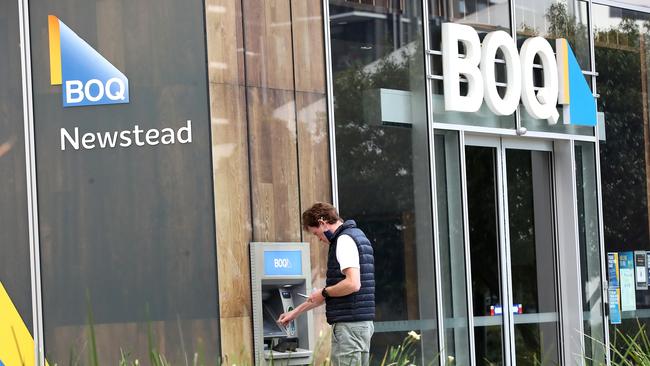Small bank struggles: BOQ woes point the way for sector under pressure
Australia’s smaller banks are confronting the triple threat of low mortgage margins, rising costs and the need to upgrade technology.

Business
Don't miss out on the headlines from Business. Followed categories will be added to My News.
Many of Australia’s smaller banks are currently facing the difficult task of navigating the treacherous markets of home and business lending, while at the same time confronting the need to undergo major technology upgrades.
The latest performance of regional lender Bank of Queensland, as well as the looming merger of Qudos Bank and Bank Australia, points to the problems facing the sector, with industry watchers warning banks are in for a tough 2025 just as a new house price boom rears its head.
BOQ, which revealed a $183m first half cash profit, also highlighted several undercurrents in Australian banking that increasingly see vitality in the sector tilted towards the majors, as the smaller players face declining mortgage margins, a rising tech bill, as well as a potential downturn amid tariffs and an inflationary hangover.
One of the smaller ASX-listed regionals, BOQ is frantically trying to complete the upgrade of its core banking platforms across its three brands, including acquisitions ME Bank and Virgin Money.
BOQ is seeking to upgrade the Temenos technology platforms powering each of these brands, before consolidating the three into one, under a transformation inaugurated by former boss George Frazis.
BOQ chief executive Patrick Allaway, who has steered the bank since Mr Frazis was dumped in 2022, warns the bank is seeking to avoid the mistakes of the past, all while trying to deliver new digital mortgages
“We will continue to invest in technology and won’t repeat the mistakes from years ago where we let our legacy systems support customers for too long,” Mr Allaway told investors.
The likes of ANZ, Westpac and NAB are all funnelling millions into their tech budgets, as the banking sector, saddled with legacy technology systems, looks to upgrade en masse.

Alongside the major tech spend, BOQ is moving to slash its branch numbers, after buying back 114 owner-managed branches, with the regional joining rivals in shrinking its footprint.
Banks of many stripes have been shuttering branches across the country as customers increasingly shift online.
At least 2337 branches have shut across Australia since 2017, in a trend that has accelerated over the last seven years.
But JP Morgan analysts warn BOQ’s ambitions may be “too optimistic”, cautioning the regional bank was facing “a very real risk” of disruption in the mortgage market, in part driven by its branch shutdowns.
The banking sector has been facing a growing squeeze in mortgage margins, as the rise of brokers pushes down returns while lenders increasingly compete away their returns.
Many of BOQ’s former branch franchise owners are expected to join the broker throng.
BOQ’s mortgage challenges are no different to the rest of the industry, with Mr Allaway noting the bank’s digital lending push had positioned it to start writing profitable mortgages “above our cost of capital”.
JP Morgan banks analyst Andrew Triggs warned BOQ “has many plates spinning at once”, cautioning there were “lots of reasons to be wary about revenue growth outlook” at the bank.
Mr Triggs noted the cost-to-income ratio targets “still look very unrealistic” and relied on an improvement in mortgage competition “that we do not expect to occur”.
Citi analysts said BOQ was showing signs it could reshape its cost base, but analyst Thomas Strong said the bank was still failing to provide confidence its return on equity ambitions of 8 per cent were achievable, warning the bank was falling short despite its muted bad debt charges.
Mr Strong said BOQ had to lift revenues to show improvements, but cautioned the bank was facing an uncertain business environment.

BOQ has attempted to pivot into business banking, with its home mortgages book taking a dive in response, but Mr Strong noted this was leaving the bank increasingly facing a funding hurdle.
Regional player Bendigo Bank was caught out on funding costs when revealing its first half results in February, after the lender was forced to tap expensive wholesale markets to fund its lending book.
In response to the challenges, some banks have been looking to bulk up through mergers, with the latest deal to combine Bank Australia and Qudos Bank one step closer to completion after members voted in favour.
The merged banks will hold more than $17.5bn in assets with 300,000 customers between them.
But that pales in comparison to the big four banks or even the regional players.
Some banks have looked to build up their business banking operations, with BOQ highlighting healthcare, commercial property and agribusiness as target markets for the lender.
But Macquarie analysts caution looming US tariffs are likely to put pressure on businesses credit growth.
“In the short term, uncertainty is likely to see businesses draw down credit facilities, which may lead to a spike in business credit growth in April,” Macquarie analysts said.
“However, this is likely to be followed by a period of weak-to-negative credit growth as
businesses pause investment decisions – as seen in 2020.”
More Coverage
Originally published as Small bank struggles: BOQ woes point the way for sector under pressure





